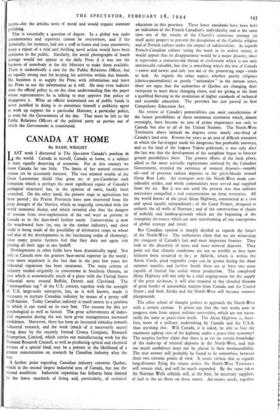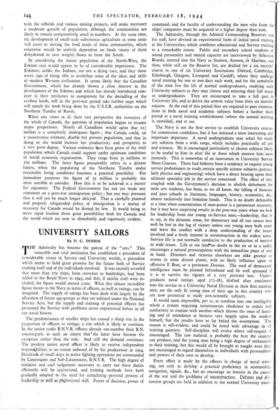CANADA AT HOME
By BASIL WRIGHT
T AST week I discussed in The Spectator Canada's position in the world. Canada in herself, Canada at home, is a subject at least equally deserving of attention. For in this country we know Canada far too little. The limits of her natural resources cannot yet be accurately forecast. The vast mineral wealth of the Ciceat Laurentian shield (that great arc of pre-Cambrian rock formation which is perhaps the most significant aspect of Canada's geological structure) has, in the opinion of some, hardly been scratched. On the other hand, the pioneer stage in agriculture has been passed ; the Prairie Provinces have now recovered from the great drought of the 'thirties, which so tragically coincided with the world economic slump, and which revealed also that the dangers of erosion from over-exploitation of the soil were as present in Canada as in the dust-bowl further south. Conservation is now the watchword here (as, too, in the timber industry), and close study is being made of the possibility of alternative crops to wheat and also of the developments in the fascinating realm of chemurgy, since many prairie farmers feel that they dare not again risk putting all their eggs in one basket.
Developments in other fields have been dramatically rapid. Not only is Canada now the greatest base-metal exporter in the world ; even more important is the fact that in the past few years her industrial expansion has been enormous. The main centres of industry tended originally to concentrate in Southern Ontario, an area which is economically much of a piece with the United States industrial areas around Buffalo, Detroit and Cleveland. The "metropolitan tug" of the U.S. centres, together with the strength of U.S. large-scale enterprise, has, as is well known, made it necessary to nurture Canadian industry by means of a pretty stiff
tariff-barrier. Today Canadian industry is much nearer to a position in which it can stand on its own feet. The reasons for this are psychological as well as factual. The great achievements of indus- trial expansion during the war have given managements increased confidence. Moreover, there has been an increased stimulus towards industrial research, and the work (much of it necessarily secret) being done by the recently formed Crown Company, Research Enterprises, Limited, which carries out manufacturing work for the National Research Council, as well as producing optical and electrical devices of a special kind, may be a pointer to the likelihood of a greater concentration on research by Canadian industry after the war.
A further point regarding Canadian industry concerns Quebec, which is the second largest industrial area of Canada, but not the second wealthiest. Industrial expansion has hitherto been limited by the lower standards of living and, particularly,, of technical
education in this province. These lower standards have been both an indication of the French Canadian's individuality and at the same time one of the results of the Church's conscious attempt (in itself quite proper) to prevent the dissipation of the Catholic religion and of French culture under the impact of industrialism. As regards French-Canadian culture (using the word in its widest sense), it would appear that its disappearance would be a major disaster, since it represents a centuries-old thread of civilisation which is not only intrinsically valuable, but also is something which the rest of Canada —rawer and newer and only just out of the pioneering stage—tends to lack. As regards the other aspect, whether purely religious (clerico-paternalistic) or purely "nationalist" in the narrow sense, there are signs that the authorities of Quebec are changing their viewpoint to meet these changing times, and are giving at the least a qualified blessing to the institution of higher standards of technical and scientific education. Thc province has just passed its first Compulsory Education Act.
No review of Canada's potentialities can omit' consideration of the future possibilities of those enormous territories which, almost overnight, have become an area of prime importance not only to Canada but also to all of the United Nations. The North-West Territories above latitude 6o degrees cover nearly one-third of • Canada's land area. Known for years as an area of difficult transport in which the fur-trapper made his dangerous but profitable journeys, and as the land of the farnous Yukon gold-rush, it was only after the last war that the development of the aeroplane began to forecast greater possibilities there The pioneer efforts of the bush pilots, allied to the more scientific explorations initiated by the Canadian Government, revealed the existence of mineral deposits—notably oil—and of precious radium deposits in the pitch-blende around Great Bear Lake. Air transport over the North-West made con- siderable strides, and whole communities were served and supplied from the air. But it was not until the present war that military necessities compelled a real concentration on these territories. All the world knows of the great Alcan Highway, constructed at a cost and speed equally extraordinary ; of the Canal Project, designed to unleash the oil wells of Norman ; and of the construction of chains of airfields and landing-grounds which are the beginning of the transpolar air-routes which are now transforming all our conceptions of global strategy and travel.
But Canadian opinion is sharply divided as regards the future of the North-West. The enthusiasts claim that we are witnessing the conquest of Canada's last and most important frontier. They look to the discovery of more and more mineral deposits. They point out that climatic conditions are not so terrible as they have hitherto been assumed to be ; at Aklavik, which is within the Arctic Circle, good vegetable crops can be grown during the short summer months, and further South there are at least two areas capable of limited but useful wheat production. The completed Akan Highway will not only be a vital staging-route for the supply of the great air-bases, it will also resound to the cheerful klaxons of great hordes of automobile tourists from Canada and the United States ; and both Alaska and the North-West will become summer playgrounds.
The other school of thought prefers to approach the North-West with a certain caution. It points out that the vast works now in progress stem from urgent military necessities, which are not neces- sarily the same as peace-time needs. The Alcan Highway is, there- fore, more of a military undertaking by Canada and the U.S.A. than anything else. Will Canada, it is asked, be able to face the enormous upkeep cost of the highway under a peace-time economy? The sceptics further claim that there is as yet no certain knowledge of the make-up of mineral deposits in the North-West, and that too much confidence must not be placed in their inexhaustibility. The true answer will probably be found to lie somewhere between these two extreme points of view. It seems certain that as regards long-distance flying the routes across the North-West Territories will remain vital, and will be much expanded. By the same token the Norman Wells oilfields will, at the least, be necessary suppliers of fuel to the air fleets on these routes. Air-routes needs, together
with the oilfields and various mining projects, will make necessary a moderate growth of population, although the communities are likely to remain comparatively small in numbers. At the same time, the development of small-scale subsistence agriculture in some areas will assist in serving the food needs of these communities, which otherwise would be entirely dependent on foods (many of them dehydrated to save weight) flown in from the South.
In considering the future population of the North-West, the Eskimo race weuld appear to be of considerable importance. The Eskimos, unlike the Indians, are not a dying race, and they show every sign of being able to assimilate some of the ideas and skills of modern Western civilisation. It seems likely that the Canadian Government, which has already shown a close interest in the development of the Eskimo, and which has already introduced rein- deer to their territories to compensate for the dwindling of the caribou herds, will in the post-war period take further steps which will match the work being done by the U.S.S.R. authorities on the Northern Tundra of Russia.
When one views in al: their vast perspective the resources of the whole of Canada, the question of population begins to assume major proportions. Nearly all Canadians would agree that ni million is a completely inadequate figure ; that Canada could, on a conservative estimate, double her present population, and that in doing so she would increase her productivity and prosperity to a very great degree. Various estimates *aye been given of the total population which Canada could support under optimum conditions of world economic organisation. They range from 35 millions to so millions. The latter figure presumably refers to a distant future, when the populating of the Northern Tundra under reasonable living conditions becomes a practical possibility. For immediate purposes the figure of 35 million is probably the most sensible to consider. How this is to be 'achieved is a matter for argument. The Federal Government has not yet made any statement on a post-war immigration policy ; but one may presume that it will not be much longer delayed. That a carefully planned and properly safeguarded policy of immigration is a matter of necessity for Canada would be denied by few. It would bring to more rapid fruition those great possibilities both for Canada and the world which are now so abundantly and vigorously evident.



























 Previous page
Previous page